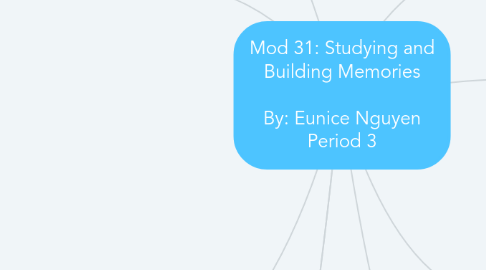
1. Parallel Processing
1.1. the processing of many aspects of a problem simulatenously
1.2. the brain's natural mode of information processing for many functions, including vision
1.3. contrasts with the step-by-step (serial) processing of most computers and of conscious problem solving
2. Connectionism
2.1. one information-processing model
2.2. views memories as products of interconnected neural networks
2.3. every time you learn something new, your brain's neural connections change, forming and strengthening pathways that allow you to interact with and learn from your environment
3. Memory-forming Process: Richard Atkinson and Richard Shiffrin (1968)
3.1. three stages total: first record to-be-remembered information as a fleeting sensory memory, process it into short-term memory, where we encode it through rehearsal, and creates memories for later retrieval
3.2. sensory memory: the immediate, very brief recording of sensory information in the memory system
3.2.1. feeds our active working memory, recording momentary images of scenes or echoes of sounds
3.3. short-term memory: activated memory that holds a few items briefly, such as the seven digits of a number while dialing
3.4. long-term memory: relatively permanent and limitless storehouse of the memory system; includes knowledge, skills, and experiences
3.5. focuses on how we process our explicit memories
3.5.1. explicit memories: memory of facts and experiences that one can consciously know and "declare". also called declarative memory
3.5.1.1. explicit memories are encoded through conscious, effortful processing
3.5.1.1.1. effortful processing: encoding that requires attention and conscious effort
4. Sterling's experiment
4.1. demonstrated iconic memory
4.1.1. iconic memory: a fleeting sensory memory of visual stimuli
4.1.1.1. echoic memory: a momentary sensory memory of auditory stimuli
5. Level of Processing
5.1. depth of processing affects long-term retention
5.2. shallow processing: encode words based on their structure or appearance
5.3. deep processing: encoding words based on their meaning
6. Memory
6.1. learning that has persisted over time
6.2. information that has been acquired, stored, and can be retrieved
7. Information-processing Models
7.1. encoding
7.1.1. a process that gets information into our brain
7.2. storage
7.2.1. a process that retains the information gained
7.3. retrieval
7.3.1. a process that later gets the information back out
8. Working Memory: Alan Baddeley and others
8.1. challenged Atkinson and Shiffrin's view of short-term memory
8.1.1. instead of being a temporary shelf for holding incoming information, it is an active desktop where your brain processes information
8.1.1.1. making sense of new input and linking it with long-term memories
8.1.1.2. working memory: a newer understanding of short-term memory that focuses on conscious, active processing of incoming auditory and visual-spatial information, and of information retrieved from long-term memory
8.2. suggested a central executive handles the focused processing
8.3. auditory rehearsal: listening to something repeatedly
8.4. visual-spatial information: mentally creating images to recreate in real life
9. Capacity
9.1. George Miller (1956) proposed that short-term memory can retain about seven information bits
9.2. working-memory capacity varies, depending on age and other factors
9.2.1. young adults have more working-memory capacity
